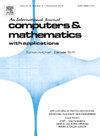H1− Galerkin mixed finite element method using tensor product of cubic B-splines for two-dimensional Kuramoto-Sivashinsky equation
IF 2.9
2区 数学
Q1 MATHEMATICS, APPLIED
引用次数: 0
Abstract
The two-dimensional Kuramoto-Sivashinsky equation offers a robust framework for studying complex, chaotic, and nonlinear dynamics in various mathematical and physical contexts. Analyzing this model also provides insights into higher-dimensional spatio-temporal chaotic systems that are relevant to many fields. This article aims to solve the scalar form of the two-dimensional Kuramoto-Sivashinsky equation using the mixed Galerkin finite element method. By introducing an intermediate variable, the equation is transformed into a coupled system. This system is then approximated using the mixed Galerkin finite element method, with the tensor product of the cubic B-spline in x and y directions serving as the test and trial functions in both the semi-discrete and fully discrete schemes. In this approach, triangularization is avoided, thereby reducing the size of the stiffness matrix. In the fully discrete scheme, the time derivative is approximated using the backward Euler method. The suitable linearization method is used to simplify the nonlinear term in both schemes. The theoretical analysis yields optimal order error estimates for the scalar unknown and its flux in the , , and norms, demonstrating the accuracy, efficiency, and stability of the proposed method. Additionally, three test problems are numerically analyzed to validate these theoretical results. The chaotic behavior of the equation is analyzed, in relation to the viscosity coefficient γ, and is also numerically investigated using the proposed method.
使用立方 B-样条张量乘的 H1- Galerkin 混合有限元法求解二维 Kuramoto-Sivashinsky 方程
本文章由计算机程序翻译,如有差异,请以英文原文为准。
求助全文
约1分钟内获得全文
求助全文
来源期刊

Computers & Mathematics with Applications
工程技术-计算机:跨学科应用
CiteScore
5.10
自引率
10.30%
发文量
396
审稿时长
9.9 weeks
期刊介绍:
Computers & Mathematics with Applications provides a medium of exchange for those engaged in fields contributing to building successful simulations for science and engineering using Partial Differential Equations (PDEs).
 求助内容:
求助内容: 应助结果提醒方式:
应助结果提醒方式:


